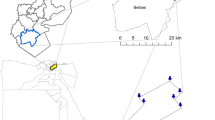Abstract
The effect of amended soil with rabbit, camel, poultry, quail, pigeon, horse, buffalo and duck manures to manage the rice root nematode, Hirschmanniella oryzae on Giza 171 rice plants, and effects of the first five manures in management of the reniform nematode, Rotylenchulus reniformis on Balady eggplants was studied under greenhouse conditions. All treatments significantly (p<-0.01) reduced final populations, rate of build-up and reproduction of both nematodes than in unamended soil. The reduction in such parameters greatly varied according to the type of the tested organic manure and the host plant. Generally, pigeon manure was highly effective against R. reniformis on eggplant followed by quail, poultry and rabbit manures, while camel treatment occupied the least potent manure. Consequently a corresponding statistical increase in eggplant growth resulted. As for managing H. oryzae on rice plants, buffalo dung was very potent inhibitor to its build-up followed by camel, horse, poultry, duck, quail, rabbit and pigeon manures. Percentages increase in the rice growth showed more values when applying duck and pigeon manures followed by quail, rabbit and buffalo. Horse dung improved, to some extent, the growth of rice plants although, none of the other organic manures succeeded in improving the rice plant growth. An explanation has been submitted to discuss the role of both pigeon droppings and buffalo dung on both R. reniformis on eggplant and H. oryzae on rice. This type of control of phytonematodes was considered economical, easy and pollution free.
Similar content being viewed by others
References
Abdel-Rahman, T., 1977: Role of organic and inorganic soil amendments in nematode control. Ph. D. Thesis, Fac. Agric., Cairo Univ.
Abid, M.;Maqbool, M. A., 1991: Effect of bare root dip treatment in oil-cakes and neem leaf extract on the root-knot development and growth of tomato and eggplant. Pak. J. Nematol.9, 13–16.
Aboul-Eid, H. Z. M., 1963: Studies on some aspects of nematode, Biological control. M. Sc. Thesis, Fac. Agric., Cairo Univ.
Alam, M. M.;Ahmed, M.;Khan, A. M., 1980: Effect of organic amendments on the growth and chemical composition of tomato, eggplant and chili and their susceptibility to attack byMeloidogyne incognita. Plant and soil57, 231–236.
Alam, A. M.;Siddiqui, S. A.;Khan, A. M., 1977: Mechanism of control of plant parasitic nematodes as a result of the application of organic amendments. III. Role of phenols and amino acids in hosts root. Ind. J. Nematol.7, 27–31.
Badra, T.;El-Bary, N. A. H., 1978: Comparative efficacy of different levels of nitrogen and phosphorus supplemented with organic amendments on tomato growth and associated withRotylenchulus reniformis. Ind. J. Nematol.8, 110–115.
Radra, T.;Saleh, M. A.;Oteifa, B. A., 1979: Nematicidal activity and composition of some organic fertilizers and amendments. Rev. Nematol.2, 29–36.
Chindo, P. S.;Khan, F. A., 1986: Effect of soil organic amendments with poultry manures on damage caused by the rootknot nematode,Meloidogyne incognita on tomato. Int. Nematol. Network Newsl.3, 30–33.
Eissa M. F. M.;Nagwa;Bary, A.;Yassin, M. Y.;Youssef, M. M. A., 1986: Efficacy of carbofuran field application on the rice root nematode,Hirschmanniella oryzae and rice yield in Northern Nile-Delta. Bull. Fac. Agric. Cairo Univ.17, 1075–1084.
Fortuner, R.;Jaco, V. A., 1976: In-vitro study of toxicity of soluble sulphides to three nematodes parasitic on rice in Senegal. Nematol.22, 343–351.
Gaur, H. S.;Meher, H. C., 1994: Integrated control of plant parasitic nematodes in tomato with nurserybed and field application of a nematicide, fertilizer and organic manure. Afro-Asian J. Nemtaol.4, 203–206.
Habicht, W. A. J., 1975: The nematicidal effects of varied rates of raw and composted sewage sludge as soil organic amendments on a root-knot nematodes. Plant. Dis. Reptr.59, 631–634.
Jenkins, W. R., 1964: A rapid centrifufal-floatation technique for separating nematodes from soil. Plant Dis. Reptr.18, 692.
Mankau, R.;Minteer, R. J., 1962: Reduction of soil populations of the citrus nematode by the addition of organic materials. Plant Dis. Reptr.46, 375–378.
Montasser, S. A., 1991: The efficacy of some organic manures in controlling of root-knot nematode of okra. Pak. J. Nematol.9, 139–143.
Muller, R.;Gooch, P. S., 1983: Organic amendments in nematode control. An examination of literature. Nematopica12, 319–326.
Muther, V. K.;Prasad, S. K., 1973: Control ofHirschmanniella oryzae associated with paddy. Indian J. Nematol.3, 54–60.
Osman, A. A., Farahat, A. A.;Amin, W. A., 1989: Organic amendments as co-agent with systemic nematicides to control nematodes infecting cowpea. Bull. Zool. Soc. Egypt38, 49–63.
Rodriguez-Kabana, R.;Jordan, J. W.;Hollis, J. P., 1965: Nematodes: Biological control in rice fields: Role of hydrogen sulfide. Science148, 524–526.
Stephan, Z. A., 1995: The efficacy of nematicides and horse manure in controlling root-knot nematodes on tomato and eggplant. Nematol. Medit.23, 29–30.
Stephan, Z. A.;Michbas, A. H.;Shakir, I., 1989: Effect of organic amendments, nematicides and solar heating on rootknot nematodes infecting eggplant. Int. Nematol. Network Newsl.6, 34–35.
Young, T. W., 1954: An incubation method of collecting endomigratory parasitic nematodes. Plant Dis. Reptr.38, 794–795.
Author information
Authors and Affiliations
Rights and permissions
About this article
Cite this article
Ismail, A.E., Youssef, M.M.A. Infleence of some organic manures as soil amendments on development and reproduction ofRotylenchulus reniformis infecting eggplant andHirschmanniella oryzae infecting rice. Anz. Schadlingskde., Pflanzenschutz, Umweltschutz 70, 58–61 (1997). https://doi.org/10.1007/BF01996923
Issue Date:
DOI: https://doi.org/10.1007/BF01996923




